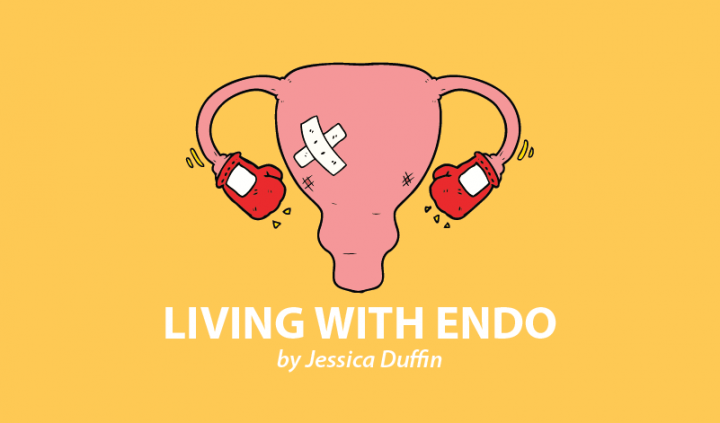Do you sometimes have difficulty recognizing yourself in the days leading up to your period? Well, you’re not alone.
Mood swings come up a lot with my endometriosis clients, especially in the second stage of their cycles. Often they’ll get through their follicular and ovulatory phases feeling good, or at least better, but as soon as their luteal phase begins, they’ll start to plummet.
While endometriosis and chronic pain have been associated with depression and anxiety, these aren’t the only reasons these issues can occur, especially if you find that they’re appearing the closer you get to your period. Often, they are at least in part hormonal, and can be the result of excess estrogen or low progesterone — or both!
Thankfully, there is much you can do to begin balancing your hormones and supporting your mental health at this time, and that’s what I want to dive into today. Of course, if you experience low moods continuously, you’re finding it hard to cope, or your PMS mood swings feel out of control, seek help from a mental health professional and consider looking into premenstrual dysphoric disorder.
Blood sugar
Blood sugar is one of the foundational components of having healthy hormone levels, as imbalanced blood sugar can lead to estrogen dominance or low progesterone. But equally important is that blood sugar dysregulation can cause feelings of anxiety, irritability, or even low moods when your levels sharply dip. Keeping your blood sugar stable by eating regularly and ensuring you have fat, fiber (from vegetables), protein, and complex carbohydrates with every meal can make a huge difference in your moods, and my clients often start feeling better when they practice this.
Root veggies
Root vegetables are the superheroes of the luteal phase. Complex carbohydrates such as squash, pumpkin, sweet potato, and beetroot contain naturally occurring sugars that feed the brain and help to raise serotonin levels — our feel-good neurotransmitters.
While simple carbs like pizza and sugar can have the same effect, they cause blood sugar dysregulation by sharply spiking blood sugar levels and then causing a rapid crash, leaving us anxious, lethargic, and irritable again. In contrast, due to the fiber, complex carbs release their sugar over a longer period, creating blood sugar levels that are much more even. As above, pair with fat, protein, and other veggies for the ideal blood sugar balancing meal.
Rather than eating root veggies quickly and in the moment that you feel bad, try incorporating some on a daily basis during your luteal phase to see if it helps even out your moods.
A mindful word of caution: I’ve personally noticed that when I eat lots of root veggies before my period, my pain levels increase when my period starts, which likely is due to the increase in sugar. Not everyone is as sensitive as I am (I find even berries before my period can spike my pain), but I wanted to share this in case anyone else experiences the same.
Vitamin C
Another shining star of the luteal phase, vitamin C helps to increase progesterone levels, as insufficient progesterone levels are associated with anxiety in the second half of the cycle. To raise your levels, try eating raw peppers, leafy greens, broccoli, and goji berries.
Magnesium
OK, OK — the final shining star. Magnesium is actually my favorite nutrient for calming moods, lowering pain, and aiding sleep. Many of my clients now have magnesium-rich baths in the lead-up to their periods, and they report a huge difference!
Magnesium has been shown to reduce period pain, alleviate anxiety, and help to clear our old and excess estrogen, which can contribute to PMS symptoms. And honestly, that’s just the icing on the cake! There’s not much this nutrient doesn’t do.
Sleep
You may roll your eyes at me, but if there was one tip from this I’d want you to take away it’s getting adequate sleep. And by adequate, I mean at least 7.5 hours. There’s no denying it, sleep deprivation is linked to causing anxiety and depression, and generally makes feeling positive much, much harder. To top it off, it can also cause blood sugar dysregulation, resulting in — you guessed it — anxiety and low moods.
Yoga
Movement! We all know how good movement is for improving our mental health, but yoga in particular has been linked to increased gamma-Aminobutyric acid (GABA) levels. Low levels of GABA are associated with mood disorders and anxiety. GABA also happens to be lower when progesterone is low, too!
I know it can be hard to motivate yourself to do any activity when you’re feeling low, but even five minutes on the mat could make a difference.
What do you do to combat mood swings during your luteal phase? Please share in the comments below.
***
Note: Endometriosis News is strictly a news and information website about the disease. It does not provide medical advice, diagnosis, or treatment. This content is not intended to be a substitute for professional medical advice, diagnosis, or treatment. Always seek the advice of your physician or other qualified health provider with any questions you may have regarding a medical condition. Never disregard professional medical advice or delay in seeking it because of something you have read on this website. The opinions expressed in this column are not those of Endometriosis News or its parent company, BioNews, and are intended to spark discussion about issues pertaining to endometriosis.

